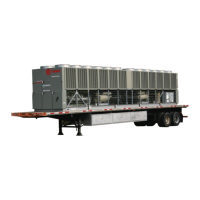RLC-SVX02G-E4
60
Unit Startup Procedures
Daily Unit Startup
The time line for the sequence of
operation begins with a power-up of
the main power to the chiller. The
sequence assumes a 2-circuit, 2-
compressor, air-cooled RTAC chiller
with no diagnostics or
malfunctioning components.
External events such as the operator
placing the chiller in AUTO or STOP,
chilled-water flow through the
evaporator, and application of load
to the chilled-water loop causing
loop water-temperature increases,
are depicted and the chiller
responses to those events are
shown, with appropriate delays
noted. The effects of diagnostics,
and other external interlocks other
than evaporator water-flow proving,
are not considered.
Note: Unless the CH.530 TechView
and building automation system are
controlling the chilled-water pump,
the manual unit start sequence is as
follows. Operator actions are noted.
General
If the prestart checkout, as
discussed above, has been
completed, the unit is ready to start.
1. Press the STOP key on the
CH.530.
2. As necessary, adjust the set point
values in the CH.530 menus using
TechView.
3. Close the fused-disconnect switch
for the chilled-water pump.
Energize the pump(s) to start
water circulation.
4. Check the service valves on the
discharge line, suction line, oil
line, and liquid line for each
circuit. These valves must be
open (backseated) before starting
the compressors.
To prevent compressor damage, do
not operate the unit until all
refrigerant valves and oil-line service
valves are opened.
5. Verify that the chilled-water pump
runs for at least one minute after
the chiller is commanded to stop
(for normal chilled-water
systems).
6. Press the AUTO key. If the chiller
control calls for cooling, and all
safety interlocks are closed, the
unit will start. The compressor(s)
will load and unload in response
to the leaving chilled-water
temperature.
After the system has been operating
for approximately 30 minutes and
has become stabilized, complete the
remaining startup procedures, as
follows:
1. Check the evaporator refrigerant
pressure and the condenser
refrigerant pressure under
Refrigerant Report on the CH.530
TechView. The pressures are
referenced to sea level (1013
mbar).
2. Check the EXV sight glasses after
sufficient time has elapsed to
stabilize the chiller. The
refrigerant flow past the sight
glasses should be clear. Bubbles
in the refrigerant indicate either
low refrigerant charge or
excessive pressure drop in the
liquid line, or an expansion valve
that is stuck open. A restriction in
the line can sometimes be
identified by a noticeable
temperature differential between
the two sides of the restriction.
Frost will often form on the line at
this point. Proper refrigerant
charges are shown in the General
Information Section.
A clear sight glass alone does not
mean that the system is properly
charged. Also check system
discharge superheat, subcooling,
liquid-level control, and unit
operating pressures.
3. Measure the system discharge
superheat.
4. Measure the system subcooling.
5. A shortage of refrigerant is
indicated if operating pressures
are low and subcooling is also
low. If the operating pressures,
sight glass, superheat, and
subcooling readings indicate a
refrigerant shortage, gas-charge
refrigerant into each circuit as
required. With the unit running,
add refrigerant vapor by
connecting the charging line to
the suction service valve and
charging through the backseat
port until operating conditions
become normal.
If both suction and discharge
pressures are low but subcooling is
normal, a problem other than
refrigerant shortage exists. Do not
add refrigerant, as this may result in
overcharging the circuit.
Use only refrigerants specified on
the unit nameplate (HFC 134a) and
Trane Oil 0048E. Failure to do so
may cause compressor damage and
improper unit operation.
